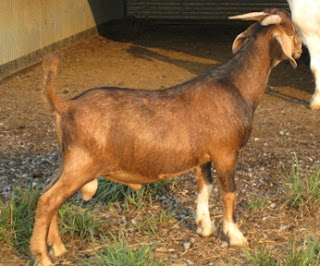Growth performance during the past 14 days was disappointing. On-average, the goats lost 0.18 lbs. per day. Only four goats posted weight gains. The highest rate of gain was 0.143 lbs. per day, achieved by two goats. Five goats maintained their weight. The remaining 38 goats lost weight. Weight loss ranged from 0.071 to 0.5 lbs. per day.
 While a few goats experienced a loss of body condition, the goats continue to be healthy and vigorous. Their recent poor performance is attributed to poor pasture quality, resulting from the continuing drought. High temperatures and humidity have also decreased grazing time.
While a few goats experienced a loss of body condition, the goats continue to be healthy and vigorous. Their recent poor performance is attributed to poor pasture quality, resulting from the continuing drought. High temperatures and humidity have also decreased grazing time.As a result of the weight loss, the average rate of gain for the 56-day duration of the test slipped to 0.17 lbs. per day, with a range of .089 to 0.357 lbs. per day. Gain averaged 0.29 lbs. per day for the first 42 days of the test and 0.42 lbs. per day for the first 28 days. The top gaining goat on the test remains the South East Cross buck consigned by Robie Robinson, followed closely by two Kiko cross bucks consigned by Jeanne Dietz-Band.
FAMACHA© scores remained relatively constant and no goat required deworming. We have not been deworming goats with FAMACHA© scores of 3, unless other reasons suggest treatment (e.g. weight loss, poor body condition, declining FAMACHA© score). No goat has had a FAMACHA© score of either 4 or 5.
Only four anthelmintic treatments have been administered to the goats so far, other than the initial treatment with moxidectin. The lack of parasitism is attributed to the drought conditions. The barber pole worm (Haemonchus contortus) requires warmth and MOISTURE to carry out its life cycle.
 Due to the widespread weight loss, we decided to give the goats a round bale of grass hay. In addition, they still have access to four nutritional tubs (CP: 16%).
Due to the widespread weight loss, we decided to give the goats a round bale of grass hay. In addition, they still have access to four nutritional tubs (CP: 16%).The research center received 0.5 inches of rain yesterday, so we remain hopeful that we will get some new grass growth. While the pastures still contain dry matter, the pasture growth is old and lacking in nutritive quality and palatability. Currently, the goats have access to the entire 10-acre grazing area. They have been observed grazing all fields in the grazing system.
Download 70-day report











